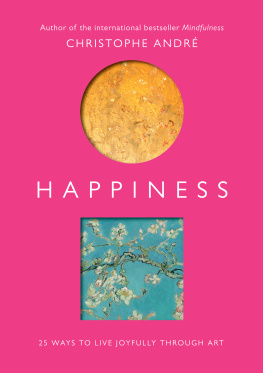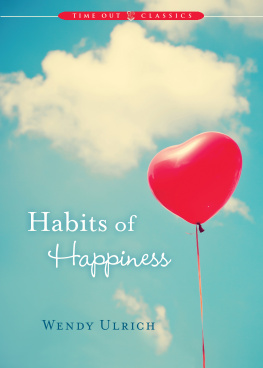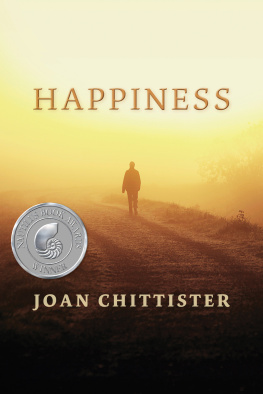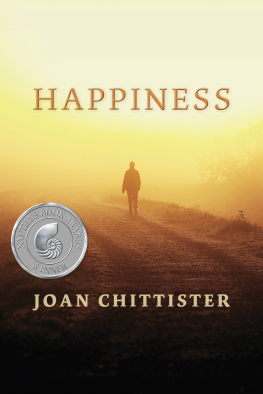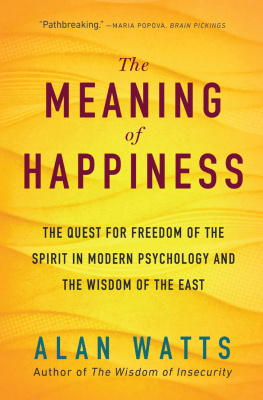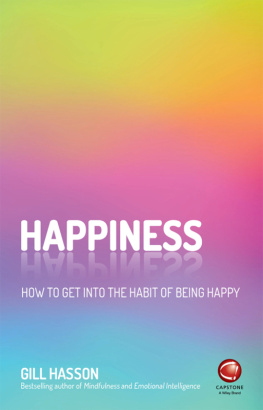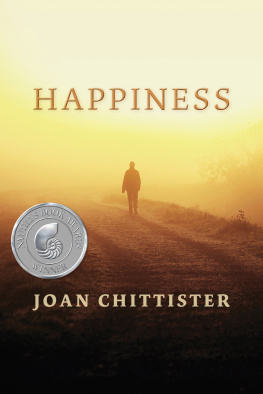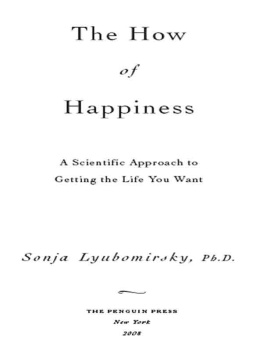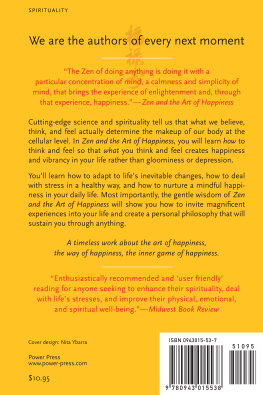CONTENTS
ABOUT THE BOOK
What does happiness look like?
For over two thousand years, philosophers have searched for it, scientists have studied it and great artists have captured it in paint. Drawing upon his ground-breaking work in the psychology of happiness and mindfulness, Christophe Andr shares 25 paintings by a wide range of masters, including Van Gogh, Vermeet and Chagall, and invites us to consider how they capture the many colours of happiness in their air, alongside its inseperable shadow, sadness.
This beautiful book explains how to look at a painting and let the picture speak and live within us. In this way, each painting in this book holds a life-changing lesson, helping us to feel, meditate and reflect and discover the meaning of happiness for ourselves.
ABOUT THE AUTHOR
Christophe Andr is the bestselling author of many books, including the internationally acclaimed Mindfulness: 25 ways to live in the moment through art . One of Frances leading psychiatrists, he works at the Sainte-Anne Hospital in Paris, where he helps people to free themselves from emotional problems such as anxiety and depression through the use of mindfulness and positive psychology.
BY THE SAME AUTHOR:
Feelings and Moods
Mindfulness: 25 ways to live in the moment through art
To Andr Comte-Sponville with warmth and gratitude.
In memory of Aleth and to Rmy for the moments of happiness and sadness spent together.
HAPPINESS
AS A WORK OF ART
Painting is a ceremony in solitude, wrote the philosopher Alain. Is it my work as a psychiatrist, my fondness for silence and my interest in the personal and emotional that draws me to painting and its power to affect us? I cant say. But I would like to help readers explore the benefits of looking at a painting, breathing gently, saying nothing and letting the picture speak and live within us making space for it within us.
In this book the faces, forms and flow of happiness are embodied in twenty-five masterpieces. These paintings encourage us to feel, meditate and reflect. They also offer twenty-five lessons to help us develop our capacity for happiness.
Some of these painters of happiness had happy lives, others were unhappy for long periods. But all were drawn to the idea of happiness and its necessity. Even the most fulfilled among them were aware that happiness is fleeting and hard to find, and that having appeared it inevitably fades.
For happiness is a living emotion, which is born, grows, blossoms, fades and vanishes. It goes in cycles, just as night follows day. This natural rhythm will be our guiding thread through the masterpieces in this book, which depict mornings, middays, dusks and nights of happiness and also, of course, its endless rebirth.
THERE ARE MANY WHO SAY, WHO WILL SHOW US ANY GOOD?
PSALM 4, OLD TESTAMENT
PRELUDE
THE ENIGMA OF HAPPINESS
Weve been searching so long for happiness that we may even come to doubt its existence or the point of pursuing it. So we get on with our ordinary lives, neither totally sad nor totally happy, until once again we sense the existence of happiness like a question to be answered, an imperious mystery to be solved.
The geographer in Vermeers painting is trying to solve an enigma of a different kind perhaps it is the mystery of Paradise. Well into the seventeenth century many people still believed that Paradise might be somewhere on Earth, and many speculated as to the most likely location the Middle East maybe, or South America. Though centuries have passed since then, the geographers quest is similar to our own. In the closed space of his room he is trying to make a map of the world, and we do the same in our thinking about happiness, based on our personal experiences.
People have always searched for happiness. The Greeks adopted it as the first goal of philosophy more than two thousand years ago. The word eudaimonia , Aristotles highest human good, is usually translated as happiness. The aim of Greek philosophy was to help human beings attain happier lives. Today, scientists have been taking a keen interest in happiness for some years they refer to it by the less poetic appellation of subjective well-being. In their eyes this well-being is good for us in many different ways, from increasing longevity and improving health to making us more altruistic.
Artists too have talked of happiness and also unhappiness, its unavoidable shadow. Poets, writers and musicians have created works that make us weep and then suddenly make us feel light-hearted, confident and happy. Painters have shown that they can arouse our emotions in more subtle ways, changing our routine, habitual view of reality, moments of happiness and feelings of unhappiness. As we seek to solve the mystery of happiness, painting can act as our enigmatic guide, speaking to us only through images and metaphors, beyond words and reason.
Our geographer too is pursuing an enigma. For a long time he has been thinking, calculating, finding answers, changing his mind and realising he has gone in the wrong direction. Now he lifts his head to the light, letting his gaze leave the room and slip out of the window which is on the left of the picture, as always in Vermeers paintings. Our geographer has done enough thinking. He has a feeling that science, work and intelligence are no longer enough. He has realised that for his quest to succeed he must now allow something else to emerge within him, something like intuition, or emotion. He has a sense that the solution to the question that has been plaguing him is not to be found outside, in maps, globes or the points of his compasses, but within. At this point in history, when human beings were gradually abandoning the belief that Paradise was on Earth or in the heavens, Vermeers geographer has a vague feeling that the Paradise whose path he seeks in fact lies within himself.
I HAVE STRIVEN NOT TO LAUGH AT HUMAN ACTIONS, NOT TO WEEP AT THEM, NOR TO HATE THEM, BUT TO UNDERSTAND THEM.
SPINOZA
The Geographer
Johannes Vermeer (16321675)
1688, oil on canvas, 52 45.5 cm, Stdelsches Kunstinstitut, Frankfurt-am-Main.
In the period when Vermeer painted this picture, science had just undergone a fundamental transformation. Until this time, conducting research into the nature of the stars, the Earth or life itself had been seen as contrary to the Divine plan. A mere thirty years before, Galileo had been condemned for his discoveries and forced, on his knees, to deny that the Earth goes round the sun. But by the seventeenth century scientific curiositas was no longer banned by the religious authorities or censured by conservative humanists.
Todays scientific research into happiness arouses ironic responses from some clerics, but this irony is unfounded and spurious. Knowing the chemical formula of a roses scent doesnt make it less exquisite or poetic.

